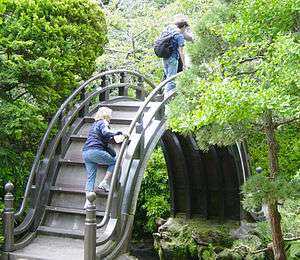Moon bridge
A moon bridge is a highly-rounded arched pedestrian bridge associated with gardens in China and Japan.[1] The moon bridge originated in China and was later introduced to Japan.[2][3][1]
| Ancestor | Arch bridge |
|---|---|
| Carries | Pedestrians |
| Material | Stone, brick, and wood |
This type of bridge was originally designed to allow pedestrians to cross canals while allowing the passage of barges beneath. When constructed using the climbing ascent and descent, it has the further advantage of not using space from the adjoining fields for approaches to the bridge.
In formal garden design, a moon bridge is placed so that it is reflected in still water. The high arch and its reflection form a circle, symbolizing the moon.
 A wooden moon bridge in the Japanese Tea Garden in San Francisco, California.
A wooden moon bridge in the Japanese Tea Garden in San Francisco, California. A full circle forms due to the shape and reflection of Hongji Bridge at Nanxun, Zhejiang.
A full circle forms due to the shape and reflection of Hongji Bridge at Nanxun, Zhejiang.
See also
- Devil's Bridge — ancient bridges, primarily in Europe, named for the precariousness or impossibility of such a bridge to last or exist in the first place, so much so that only the Devil could have built it.
References
- Bernal, Peggy Park (1999). The Huntington Library, Art Collections, and Botanical Gardens. San Marino, California: Huntington Library. p. 23. ISBN 9780873281348.
Moon bridges were a feature of Chinese garden architecture, adopted by the Japanese in the thirteenth century. The large, rounded bridge is usually known as a moon bridge because the arch and the reflection in the water below form a full form a full moon shape, and also because “moon viewing” from beneath the bridge was a diversion for estate owners cruising on their private lakes.
- Boults, Elizabeth; Sullivan, Chip (2010). Illustrated history of landscape design. Hoboken, NJ: J. Wiley. p. 118. ISBN 978-0-470-28933-4.
- Ono, Kenkichi; Edwards, Walter. "full-moon bridge 偃月橋・円月橋". Japanese Garden Dictionary: A Glossary for Japanese Gardens and Their History. Retrieved 2 September 2011.
| Wikimedia Commons has media related to Moon bridges. |
This article is issued from Wikipedia. The text is licensed under Creative Commons - Attribution - Sharealike. Additional terms may apply for the media files.
